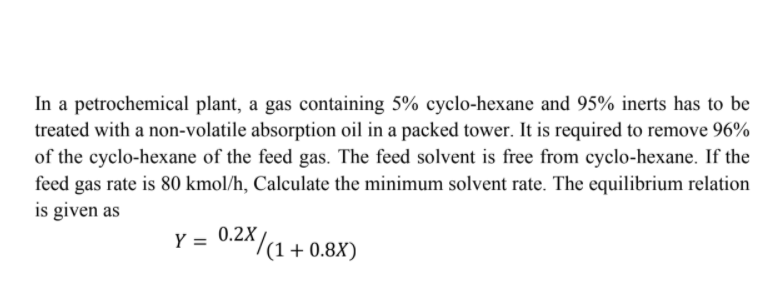In a petrochemical plant, a gas containing 5% cyclo-hexane and 95% inerts has to be treated with a non-volatile absorption oil in a packed tower. It is required to remove 96% of the cyclo-hexane of the feed gas. The feed solvent is free from cyclo-hexane. If the feed gas rate is 80 kmol/h, Calculate the minimum solvent rate. The equilibrium relation is given as Y = 0.2X/(1 + 0.8X)
In a petrochemical plant, a gas containing 5% cyclo-hexane and 95% inerts has to be treated with a non-volatile absorption oil in a packed tower. It is required to remove 96% of the cyclo-hexane of the feed gas. The feed solvent is free from cyclo-hexane. If the feed gas rate is 80 kmol/h, Calculate the minimum solvent rate. The equilibrium relation is given as Y = 0.2X/(1 + 0.8X)
Introduction to Chemical Engineering Thermodynamics
8th Edition
ISBN:9781259696527
Author:J.M. Smith Termodinamica en ingenieria quimica, Hendrick C Van Ness, Michael Abbott, Mark Swihart
Publisher:J.M. Smith Termodinamica en ingenieria quimica, Hendrick C Van Ness, Michael Abbott, Mark Swihart
Chapter1: Introduction
Section: Chapter Questions
Problem 1.1P
Related questions
Question
In a petrochemical plant, a gas containing 5% cyclo-hexane and 95% inerts has to be treated with a non-volatile absorption oil in a packed tower. It is required to remove 96% of the cyclo-hexane of the feed gas. The feed solvent is free from cyclo-hexane. If the feed gas rate is 80 kmol/h, Calculate the minimum solvent rate. The equilibrium relation is given as
Y = 0.2X/(1 + 0.8X)

Transcribed Image Text:In a petrochemical plant, a gas containing 5% cyclo-hexane and 95% inerts has to be
treated with a non-volatile absorption oil in a packed tower. It is required to remove 96%
of the cyclo-hexane of the feed gas. The feed solvent is free from cyclo-hexane. If the
feed gas rate is 80 kmol/h, Calculate the minimum solvent rate. The equilibrium relation
is given as
Y = 0.2X
^/
(1 + 0.8X)
Expert Solution
This question has been solved!
Explore an expertly crafted, step-by-step solution for a thorough understanding of key concepts.
Step by step
Solved in 7 steps with 1 images

Knowledge Booster
Learn more about
Need a deep-dive on the concept behind this application? Look no further. Learn more about this topic, chemical-engineering and related others by exploring similar questions and additional content below.Recommended textbooks for you

Introduction to Chemical Engineering Thermodynami…
Chemical Engineering
ISBN:
9781259696527
Author:
J.M. Smith Termodinamica en ingenieria quimica, Hendrick C Van Ness, Michael Abbott, Mark Swihart
Publisher:
McGraw-Hill Education

Elementary Principles of Chemical Processes, Bind…
Chemical Engineering
ISBN:
9781118431221
Author:
Richard M. Felder, Ronald W. Rousseau, Lisa G. Bullard
Publisher:
WILEY

Elements of Chemical Reaction Engineering (5th Ed…
Chemical Engineering
ISBN:
9780133887518
Author:
H. Scott Fogler
Publisher:
Prentice Hall

Introduction to Chemical Engineering Thermodynami…
Chemical Engineering
ISBN:
9781259696527
Author:
J.M. Smith Termodinamica en ingenieria quimica, Hendrick C Van Ness, Michael Abbott, Mark Swihart
Publisher:
McGraw-Hill Education

Elementary Principles of Chemical Processes, Bind…
Chemical Engineering
ISBN:
9781118431221
Author:
Richard M. Felder, Ronald W. Rousseau, Lisa G. Bullard
Publisher:
WILEY

Elements of Chemical Reaction Engineering (5th Ed…
Chemical Engineering
ISBN:
9780133887518
Author:
H. Scott Fogler
Publisher:
Prentice Hall


Industrial Plastics: Theory and Applications
Chemical Engineering
ISBN:
9781285061238
Author:
Lokensgard, Erik
Publisher:
Delmar Cengage Learning

Unit Operations of Chemical Engineering
Chemical Engineering
ISBN:
9780072848236
Author:
Warren McCabe, Julian C. Smith, Peter Harriott
Publisher:
McGraw-Hill Companies, The